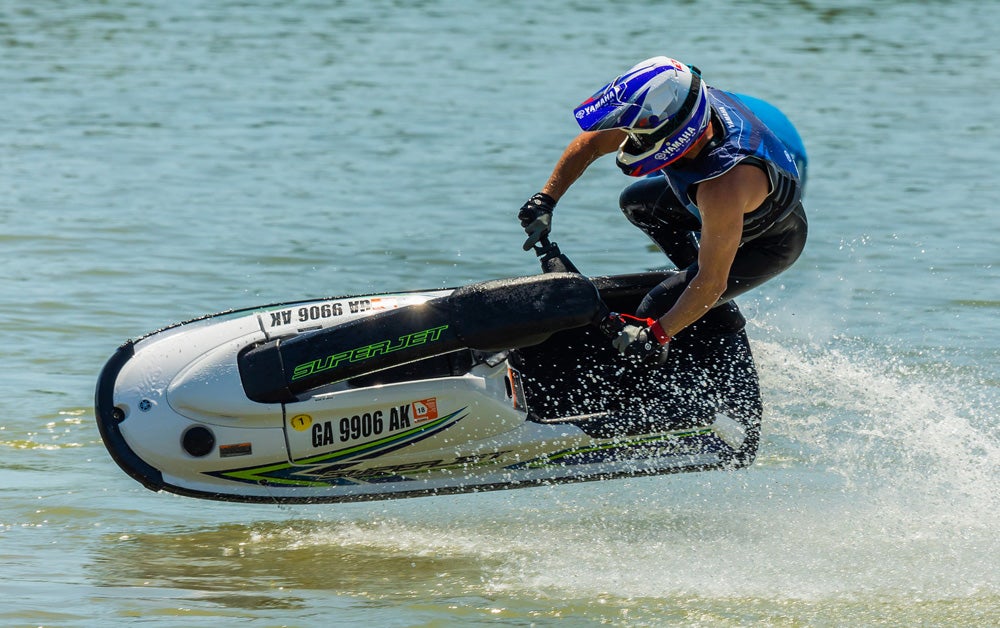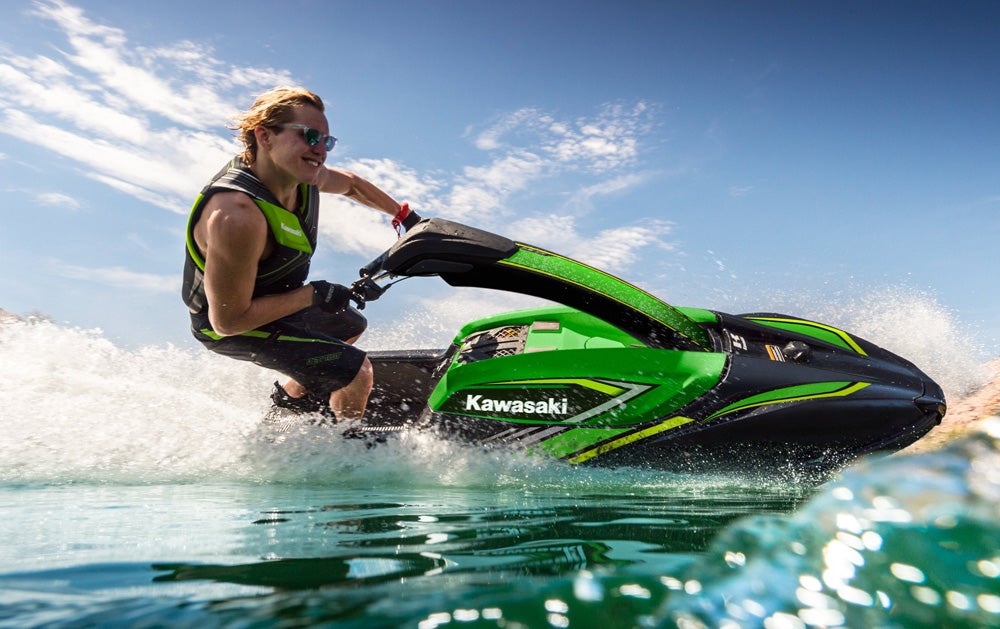2019 Kawasaki SX-R vs. Yamaha SuperJet
The only two stand-up craft left appeal to distinctly different audiences
Stand-up PWC enthusiasts have a lot in common, but the craft they ride have never been more different. They’re vastly different in size, horsepower, handling…you name it, they’re different. And that’s a good thing. Why? Because for probably the first time since the market began, there are two models that aren’t just each manufacturer’s take on the same, but actually serve distinctly different audiences. Let’s take a look at how the 2019 Kawasaki SX-R and Yamaha SuperJet compare.
Availability
Before we get into a comparison of each boat, it’s necessary to first address the elephant in the room…or rather the two-stroke in a world of four-strokes. One of the consequences of modern emissions laws is that two-stroke engines were essentially regulated out of the personal watercraft marketplace. Kawasaki pulled the plug on its last two-stroke standup in 2011. Yamaha, however, has continued to offer the two-stroke-powered SuperJet to consumers. The catch? It’s in rather large print right on the model’s web page — “Available for closed course competition use only.”
What does that mean? Technically it means that the Yamaha SuperJet is to be sold to racers, and used purely for “closed course” racing, although pretty much anyone can join an association like the International Jet Sports Boating Association (IJSBA) or American PowerBoat Association (APBA) and get a competition license. Even then, the craft are not available for sale in California and New York. As to other states, the answers are murky. Many buyers report they are still able to register and use the craft, and not just in a strictly competition setting.
Kawasaki, meanwhile, switched to four-stroke power when the company reintroduced the standup SX-R in 2017. There are currently no regulations on the craft’s sale or use.
Horsepower-to-Weight
In addition to the Kawasaki being a four-stroke and the Yamaha a two-stroke, the two craft currently available also boast significantly different levels of horsepower.
The 2019 Kawasaki SX-R engine is borrowed from the STX-15F (as is the 148mm pump), meaning it produces a potent 150-160hp from its 1,498cc mill. That’s twice the power the last Kawi standup produced. Yes, the craft weighs substantially more as well (551 pounds), but the power on tap mostly makes up for the added weight. Acceleration is downright brutal out of the hole, even besting Kawasaki’s top-of-the-line Ultra 310R. Top speed for a skilled rider can push up to 62 mph.
Contrast that with the Yamaha SuperJet’s long-running 701cc, twin-cylinder two-stroke. It produces about 73 hp, but the craft only weighs 306 pounds.
Acceleration isn’t brutal, but definitely comes on strong. Top speed averages about 45 mph. As to those emissions, the 2019 Kawasaki SX-R is substantially cleaner…as you would expect.
Dimensions
Like horsepower and weight, physical dimensions are also dramatically different. Side by side the craft look like apples and oranges, with the reintroduced Jet Ski now substantially larger than its predecessors. The 2019 Kawasaki SX-R measures in at 8’ 9” in length, 2’ 6” in width, and 2’ 9” in height. Compare that to the Yamaha SuperJet at 7’ 4” in length, 2’ 3” in width and 2’ 4” in height.
Put away the tape measure and just study the two craft and other differences emerge. The Kawasaki has a lot of both length and girth forward of the handle pole (the same pole, incidentally, used on the previous standup model) and a rather dramatic bow shape; one that looks pointy at a distance but up close reveals a significant flare. There’s also a lot of hull depth below the craft’s bondline and the rider “tray,” at 2’ 10” x 1’ 4”, is more spacious.
Storage and trailering are worth considering. Yamaha SuperJet owners can still throw one in the back of a pickup with the help of a friend. Kawasaki SX-R buyers better get used to hauling a trailer.
Handling
Though, like riding a bike, each craft uses the same obvious technique, on the water the two craft feel quite different, and it’s this difference that will likely decide which way most standup buyers will go when choosing a craft.
The relatively new 2019 Kawasaki SX-R is quite stable for a standup. An average-sized rider can probably pull themselves to their knees without sinking the stern, and once underway, the hull feels exceptionally stable. It’s the more obvious choice for larger riders who previously had difficulty with standups simply due to size.
Crank that first turn at medium speed and the SX-R hull stays locked in whether you’re leaning inside or riding flat, but as speeds increase you’ll definitely want to increase the weight shifting to the inside of the turns. Here, the power in turns is shocking if you’re used to old-school standups, as is the grip. The craft literally wants to rocket its way through the corners. Still, misjudge your weight shifts and you can end up in the water fast.
In comparison, the Yamaha SuperJet can also crank an impressively sharp turn, albeit with significantly less power and potential speed. Still, it’s agile and rails through its corners with similar authority.
Where the SuperJet excels, however, is in terms of sheer playfulness. The Kawasaki feels big, heavy, powerful, and built for a course of buoys. The SuperJet, however, feels ready to jump off a wave, play and be muscled about by its rider. It’s the clear choice between the two for freestyle-minded riders.
Features
As to extras, don’t expect much from either craft. These are boats with a mission, and storage and electronic enhancements aren’t part of many rider’s must-have lists.
That said, the 2019 Kawasaki SX-R does feature a magnetic key ignition for theft prevention, a rubber netting atop the hood cover to “trap” small items (like a dockline) underneath, and the handlepole receives two prominent warning lights for low fuel or engine trouble.
The Yamaha SuperJet is pretty much status quo, but you do get welcome padding atop the gunwales. Kawasaki leaves this area bare fiberglass for sleek looks, but padding is occasionally missed, especially during repeated deepwater boarding and starts.
Decision Time
Prospective buyers probably already know which craft is the best fit for them just from these descriptions, but if you’re still on the fence take a test ride and your decision should be obvious. Like high speeds, hellacious cornering, stability and the benefits of a clean, modern four-stroke? Go with the 2019 Kawasaki SX-R. Like a light and playful boat that you can still influence with body english and willing to deal with potential two-stroke hassles? The Yamaha SuperJet is the obvious choice.
Specs
| 2019 Kawasaki SX-R | 2019 Yamaha SuperJet | |
| Engine | Inline four-cylinder, four-stroke, 1,498cc | Two-cylinder, two-stroke, 701cc |
| Fuel Capacity | 6.1 gal. | 4.8 gal. |
| Curb Weight | 551.3 lbs | 306 lbs |
| Length x Width x Height | 8’9″ x 2’6″ x 2’9″ | 7’4″ x 2’3″ x 2’4″ |
| MSRP | $9,999 | $8,499 |
| Complete Specs | Link | Link |
Get PersonalWatercraft.com in your Inbox!
Like PersonalWatercraft.com on Facebook
Comments
Most Popular

2025 Yamaha JetBlaster PRO 2-Up Review

Remembering the Sea-Doo XP

2024 Kawasaki Jet Ski STX 160X Review

Whatever Happened to the Wetbike?

2025 Yamaha JetBlaster Review




















 Your Privacy Choices
Your Privacy Choices